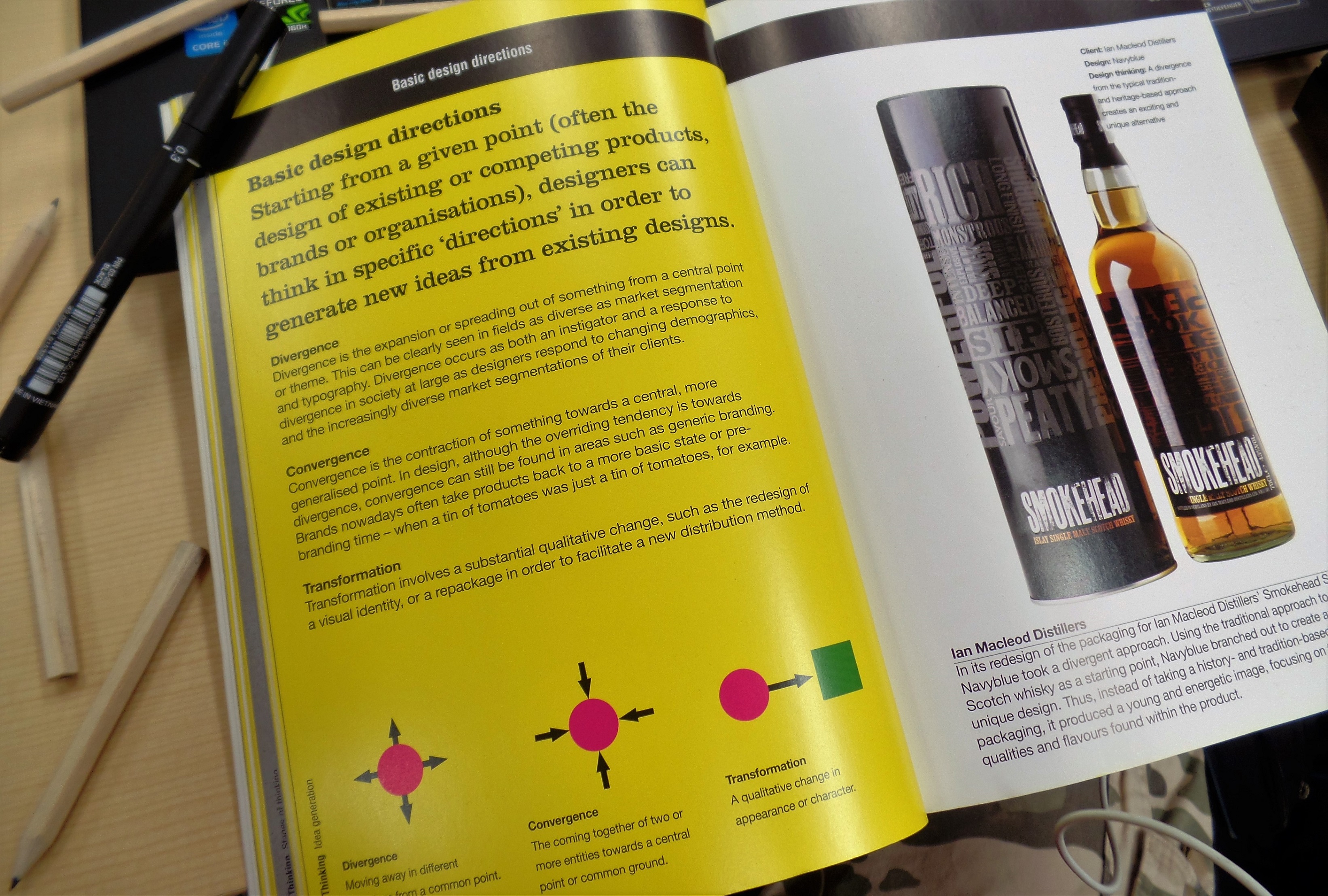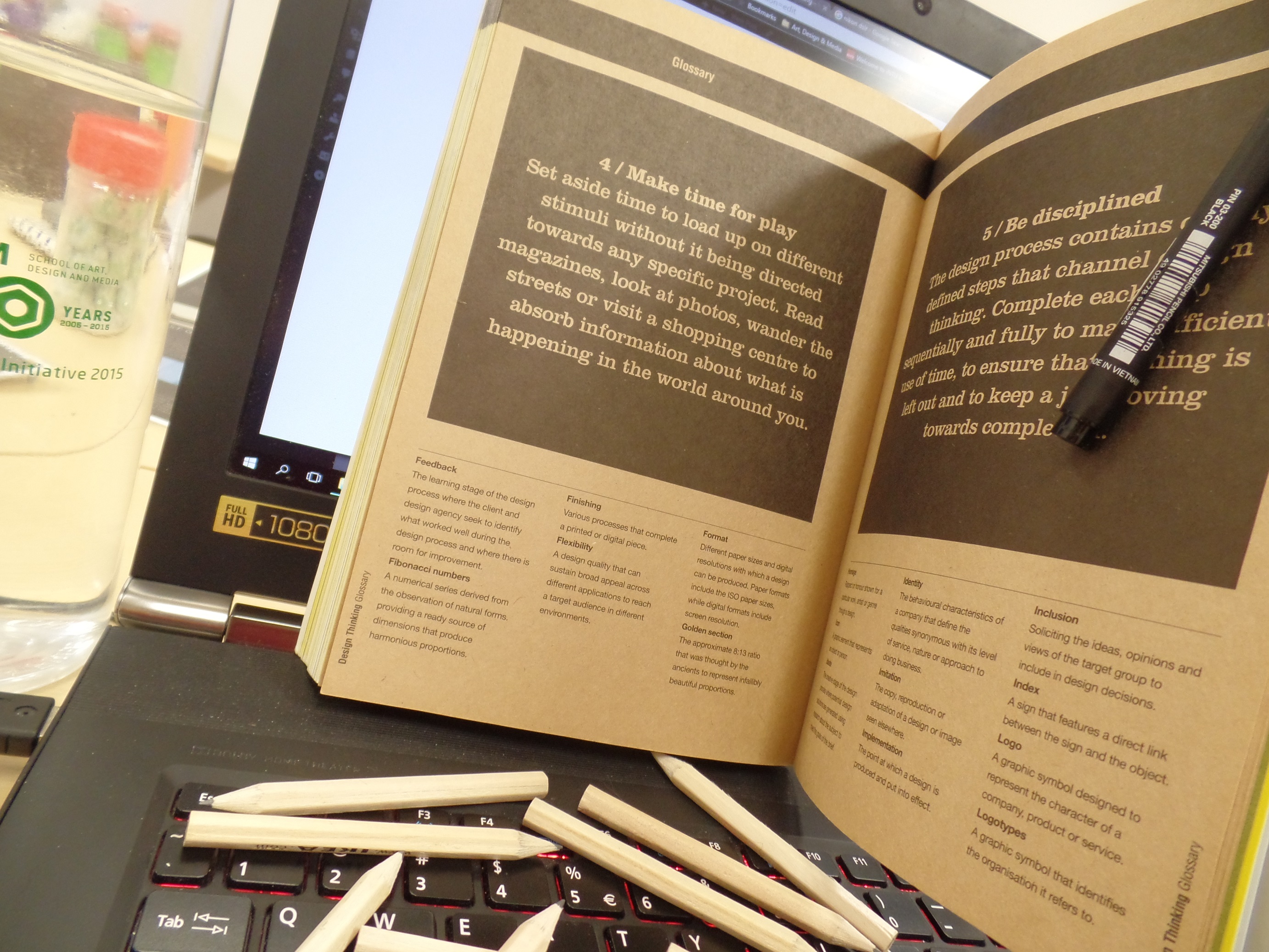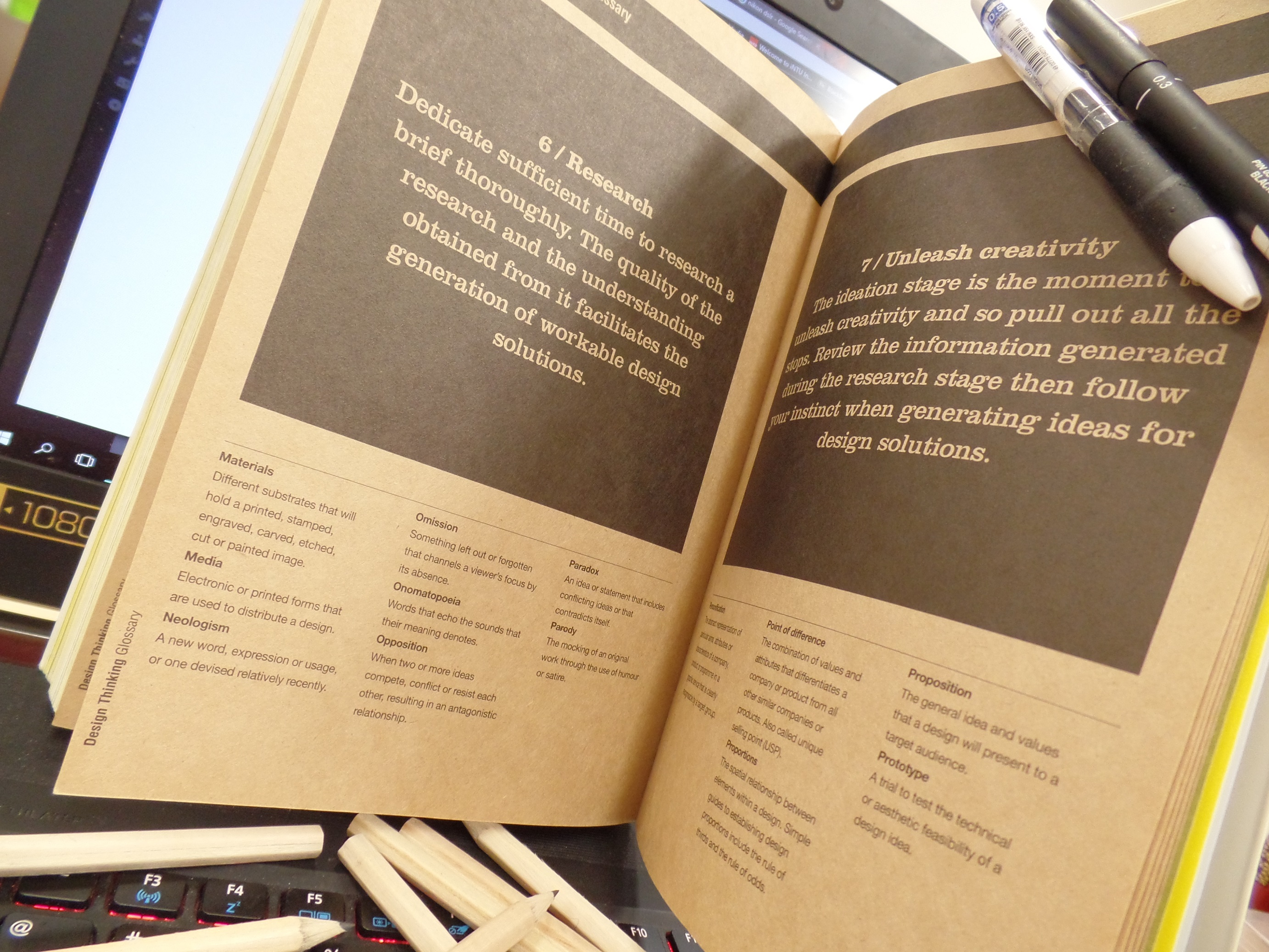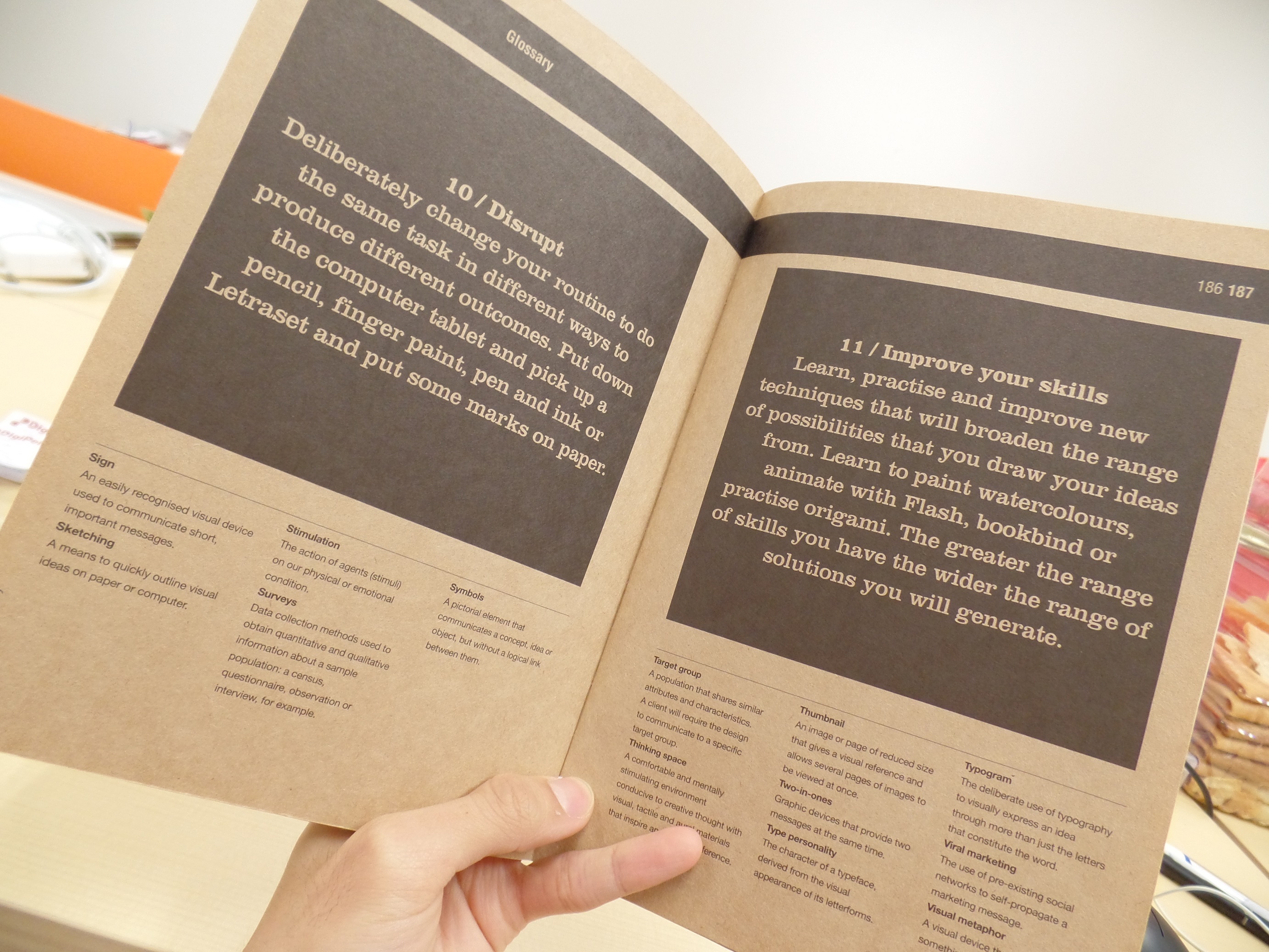While researching for Project 2, I came across this textbook – Basics Design 08: Design Thinking by Gavin Ambrose and Paul Harris. I thought what is taught in the book is pretty useful and I want to share them with everyone here.
“You cannot hold a design in your hand. It is not a thing. Is is a process. A system. A way of thinking.” – Bob Gill, Graphic Design as a Second Language

The Design Process
1) Define – Understanding of problems and constraints and determines what is necessary
2) Research – Information like history, end-user research, interviews and potential obstacles
3) Ideate – End-user motivations and needs are identified, generating ideas through brainstorming
4) Prototyping – Resolve/working-up of ideas to present to user-group and stakeholders
5) Selection – See proposed solutions against design brief objective
6) Implementation – Design development and final delivery
7) Learning – Help designer improve, seek feedback and identity improvements
————————
Stage 1 – Define
Clients have varying experiences of design service – quality of briefs will also vary. It will need to be rewritten and reworked if not robust enough.
Checklist:
– Do you understand what the client is asking for?
– Does the client understand what they are asking for?
– Do you agree on the definition of terms?
– Does the brief have any flaws?
– Can you manage the clients expectation?
Ask yourself:
– Who is the client and target audience?
– What design solution is the client thinking of?
– When will the design be needed and for how long?
– Where will the design be used?
– Why does the client think a design solution is required?
– How will the solution be implemented?
————————
Stage 2 – Research
Can be either quantitative (hard statistical numbers) or qualitative (information about consumers, and lifestyle habits). Can also includes factors like education, career, holiday destinations, musical tastes, aspiration etc.
Primary Research – Feedback generated during learning phrase of projects with same or similar clients
Secondary Research – Information obtained from general secondary sources (market research report)
Checklist:
– Do you have feedback from previous projects?
– Do you have a statistical composition of the user group?
– Do you understand the target market?
– What is the education level/typical lifestyle/aspiration of user group?
~*Personally, I think that research also encompass understanding the subject matter (such as an ad for toothpaste requires a deeper understanding of the toothpaste and its market than the general public). Articles, books, videos, other company’s ads, etc are good source to find inspiration.
————————
Stage 3 – Ideate
During this stage, the team draws on research gathered and constraints established. This information is used to create ideas.
Some ideation methods includes brainstorming, sketching ideas, or adapting a tried-and-tested design that already exists. Feedback should be sought throughout the design process to clarify points and doubts.
Basic design directions includes divergence, convergence and transformation.
Themes of thinking includes KISS (Keep It Simple Stupid), Focus, Top down/Bottom up and Ockham’s Razor/Principle of Parsimony/Law of Economy:
– KISS’s idea is to pare back on the design and keep it to its essential elements and requires a clear understanding of the concept.
– Focus – Select only key message of the elements as the focus, other information can be provided via other communication channels, an example is the Pokemon 20th Anniversary Super Bowl ad:

Instead of focusing on any of advertising for any specific Pokemon products, it focus on the joy of training and playing Pokemon and being the best, and generally setting the spirit of the Pokemon franchise high.
– Top down/Bottom up – Look at design problem from system perspective and ‘drills’ down to add detail or focus on the basic elements and work upwards to link them together
– Ockham’s Razor – Elements not needed should not be included, to produce something simpler to prevent risk to introducing inconsistencies, ambiguities, and redundancies.
There are a few types of prototypes which includes sketching, model (replica of design in 3 dimensions), maquette (same as model but with an overview in relation to its setting/location), printer’s dummy (full-scale mock-up), scale (can be reduced or enlarged).
Checklist:
– Do you understand the brief?
– Do you have sufficient research information?
– Which methods will be used for idea generation?
————————
Stage 4 – Prototype
A prototype is used to test the technical feasibility of design idea and can include novel packaging or presentation. It also allows design team and client to visualise and handle a design concept with an idea of its physical presence and tactile qualities. A prototype need not be created using the final materials.
Checklist:
– Do you understand the brief?
– Do you have sufficient research information?
– Which methods will be used for idea generation?
You can read more about product design prototype here (http://inertia-prototypes.com/the-product-prototypes-design-process/).
————————
Stage 5 – Select
This is the stage where one proposed design solution is chosen for development. The chosen design is typically meet closest to the brief. Cost and time are also relevant in the selection process.
Checklist:
– Does the design meet the defined needs of the brief?
– Does the design resonate with the target audience?
– Can the design be produced on time and on budget?
– Are there other factors to take into account?
– Has the client signed off the design?
————————
Stage 6 – Implement
This is the part where the design artwork and format specification is delivered to the suppler to be produced (printer, web builder, fabricator). Project management is usually needed in order to ensure the end results meets design expectation and to keep project on time and budget. Proofing may be needed before the final delivery to the client.
Some things to take note of final deliverable includes:
– Format – paper size, dimension
– Materials – Thickness of paper, type of paper (ie textured paper vs smooth paper), printed/stamped/engraved/carved/etched/cut or painted.
– Finishing – Folding/die cutting/varnishing/embossing etc, or for digital (animation, sound, interaction, etc)
– Scale – Thinking big vs thinking small (ie giant coffee cup sculpture to advertise a cafe)
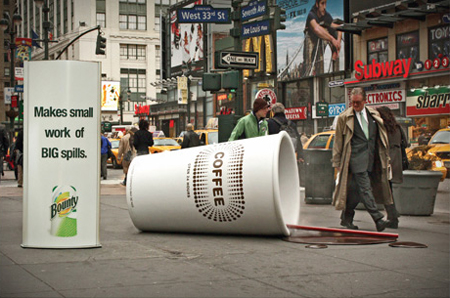

Checklist:
– Has the client signed off the design?
– Have printers or other production professionals been booked?
– Has the artwork been delivered to production professionals
– Has the job been proofed against the design?
– Has the finished job been delivered?
————————
Stage 7 – Learning
This is the final stage and it involves learning from what has happened throughout the design process. This is when everyone identity what worked well and where there is room for improvement. The feedback generated becomes a learning opportunity for future projects. It can help with a shared understanding between designers and clients and also optimize design solutions in the future.
It should be noted this stage also occurs throughout the design process. Successful design comes from our ability to learn and enhance our design thinking.
Checklist:
– Has dialogue with the client about the success of implementation taken place?
– How success was the implementation?
– What feedback has the client received or commissioned?
– What aspect can be improved?
————————
Some wise words I thought it could help us grow as an artist and a designer:
Thank you for reading!



